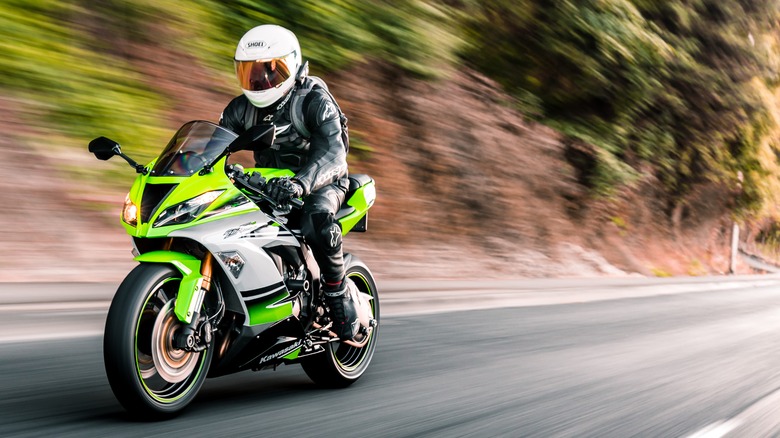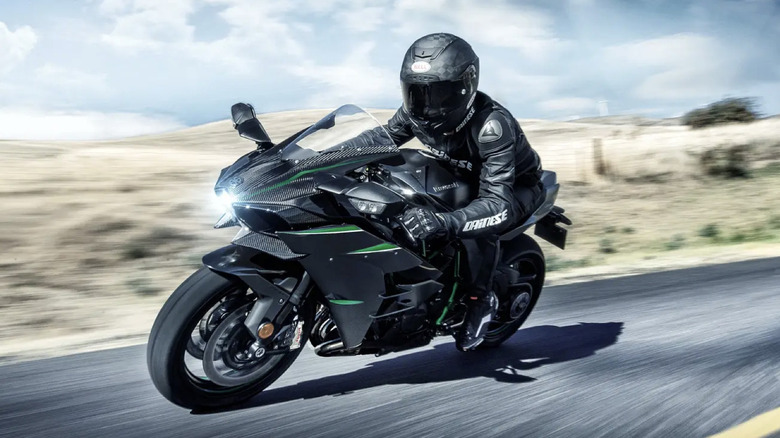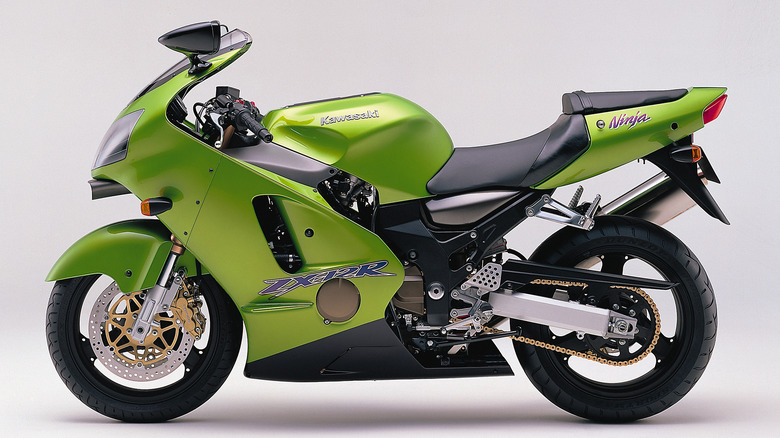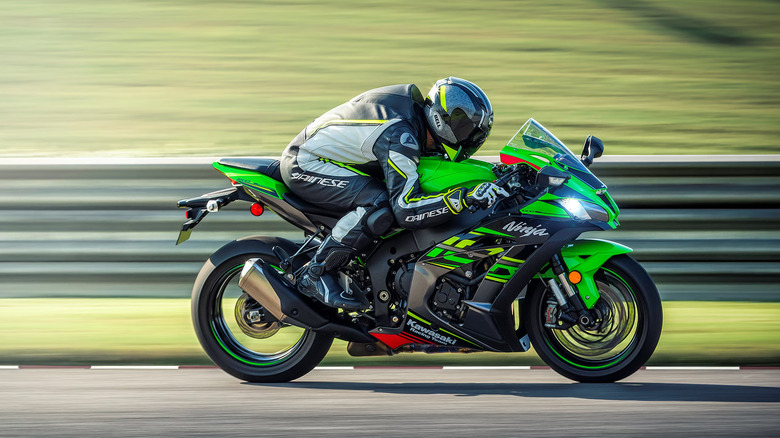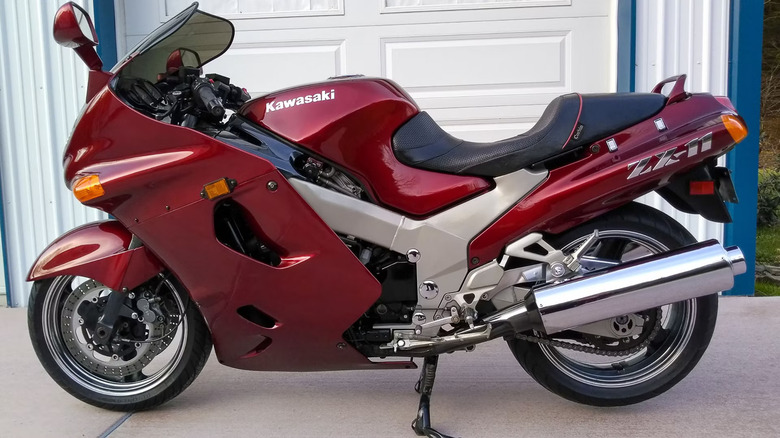5 Of The Fastest Motorcycles Kawasaki Ever Built
Kawasaki is a motorcycle brand known for its blisteringly fast superbikes, high-end builds, and relative affordability. This trifecta, coupled with its rich history, has elevated the motorcycle manufacturer to the upper echelons of the industry, as it currently holds the distinction of being one of the most highly reputable names in the market.
Kawasaki did not achieve such a vaunted level of success by being confined to the standards of the time, though. To become the iconic Japanese motorcycle manufacturer that it is today, the company needed to revolutionize and innovate at every twist and turn. It did so by crafting some of the most powerful motorcycle engines in existence that push the envelope further beyond. With a goal firmly in sight, Kawasaki has effectively built a reputation for stylish and lightning-fast superbikes. Simply put, Kawasaki motorcycles are best described as rockets on two wheels. That said, strap in and hold on tight, motorcycle aficionados, and discover the top five fastest motorcycles Kawasaki has built to date.
Kawasaki Ninja H2R
The Ninja H2R is a superbike that is exclusively used on the race track, which means it is not a street-legal motorcycle. As such, Kawasaki was unrestricted with its development, which shows in the superbike's recorded top speed. The race-only Ninja H2R was infused with an engine created to be as powerful as humanly possible, with a maximum top speed of 240 mph (386 km/h). You can guess why this literal crotch rocket is strictly used within the confines of a race track. The street-legal variation is the Kawasaki Ninja H2, which still boasts a brow-sweating top speed of 209 mph (336 km/h), which still makes it quite a beastly machine.
The Kawasaki Ninja H2R achieves this mind-bending speed by incorporating a design called forced induction, which forces more air intake into the combustion chamber. What this does is cause more fuel to be injected to generate more horsepower than normal. With its 998cc air-cooled engine and lightweight frame and design, very few can hold a candle to this ultra-fast Kawasaki motorcycle. As of this writing, the Ninja H2R has also successfully proven that it can hit the mythical 248 mph (400 km/h) top speed.
Kawasaki Ninja ZX-14R
Coming in second is the Ninja ZX-14R with its 186 mph (299 km/h) top speed, which it can push up to 200 mph (321 km/h) when unrestricted. Debuting at the 2005 Tokyo Motor Show, the Ninja ZX-14R quickly took over the mantle of Kawasaki's flagbearer from the ZZ-R1200 (ZX-12C). The Ninja ZX-14R remained relatively unchanged for six years up until it was given a major overhaul in 2012. The revamped ZX-14R incorporated a sleeker look and upgraded ignition, exhaust system, and three-mode Kawasaki traction control.
However, the Ninja ZX-14R inevitably had its full potential stifled due to the unofficial gentleman's agreement between European and Japanese manufacturers to limit the top speeds of future motorcycles to 186 mph (300 km/h). This agreement has been somewhat overlooked from time to time, however. Equipped with a monstrous 1,352cc engine, which it has since updated to 1,441cc, the ZX14R should be treated with the utmost respect. Riding anything around the 1,000-cc range can be quite challenging, even for experienced riders, and with the ZX-14R's 0 to 60 mph in 2.85 seconds, it is not a motorcycle that you should underestimate.
Kawasaki Ninja ZX-12R
The Ninja ZX-12R was only in production from 2000 to 2006 and was the tinder that sparked the unofficial agreement of Japanese and European motorcycle manufacturers to limit the top speed to 186 mph (300 km/h). However, the first-generation ZX-12R models do not have this restriction and are said to reach top speeds of around 200 mph (321 km/h). The ZX-12R is equipped with a beefy 1,199cc engine with a ram-air intake that is also used by its successor, the Ninja ZX-14R.
The ZX-12R has an average output of 178hp which is heightened by the ram-air engine to 190 horsepower. Over the years during its prime, the ZX-12R has undergone several upgrades and tweaks here and there. As a pioneer superbike in the industry, most of the core designs used in the ZX-12R were re-used and polished for the superior ZX-14R. Nowadays, the Ninja ZX-12R is fondly remembered as the trailblazer that paved the way for the best Kawasaki superbikes to shine. While it is certainly an older model, the ZX-12R can still give newer superbikes a run for their money with its solid overall performance.
Kawasaki Ninja ZX-10R
The first Ninja ZX-10R model was released in 2004 and has since garnered significant acclaim, which cemented it as one of the best and most popular of the Ninja motorcycle series. Its rise to prominence within the motorcycle industry was supplemented when it won the Cycle World's "Best Superbike" award as well as the international Masterbike competition in 2004 and 2005, respectively.
The ZX-10R initially had a top speed of 180 mph (289 km/h), but has since surpassed that limit with 186 mph (299 km/h) by models released from 2016 onwards. The Ninja ZX-10R saw a significant upgrade with its design, courtesy of the Kawasaki WSBK team, with one major change being the lighter crankshaft. This alteration boosted the power of its already powerful 998cc in-line four-cylinder engine from 175 horsepower to 197 horsepower.
To this day, the Ninja ZX-10R is still a staple on race tracks around the world and maintains its standing as one of the longest-standing national-level superbikes in the industry. Its reputation as one of Kawasaki's premier motorcycles is both well-deserved and earned.
Kawasaki Ninja ZX-11
The explosion in popularity of Japanese motorcycles in the 1990s can be attributed to Japanese superbikes such as the Kawasaki Ninja ZX-11 that debuted in 1989. For six years since its introduction, the Ninja ZX-11 held the crown as the fastest-production motorcycle in the market with a top speed of 175 mph, a distinction that also reinforced Kawasaki's claims as one of the best motorcycle brands in the business. The ZX-11 left its competition in the dust thanks to its liquid-cool 1,052cc in-line four-cylinder engine that has a power output of 145 horsepower and torque that hits around 108.5 Nm.
As the successor to the Kawasaki Tomcat ZX-10, the Ninja ZX-11 certainly took what the Tomcat ZX-10 built and carried it to the next level. While the ZX-12R is often cited as the one that set the table for the truce between Japanese and European motorcycle manufacturers to limit all production superbikes's top speed, it is the ZX-11 that undeniably started the "Speed War" between East and West.
Looking back at the Kawasaki Ninja ZX-11, it is unquestionably one of the true pioneering superbikes that signaled the new age of liter-class motorcycles. Kawasaki was among the leaders in terms of innovation, cutting-edge design, and technological advancements in the field of sports bikes, whose ripples are still felt to this day.
